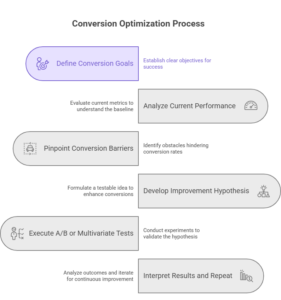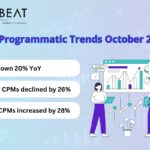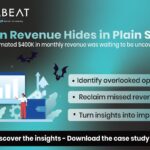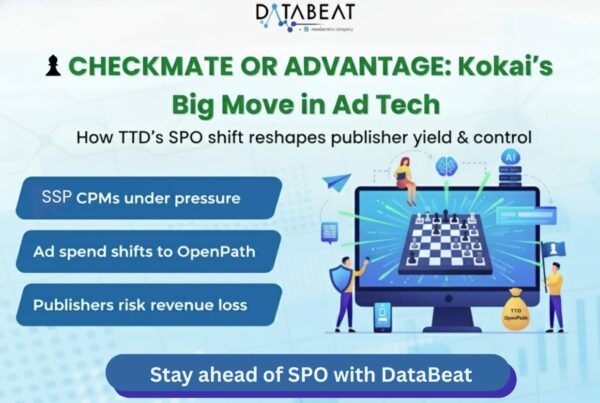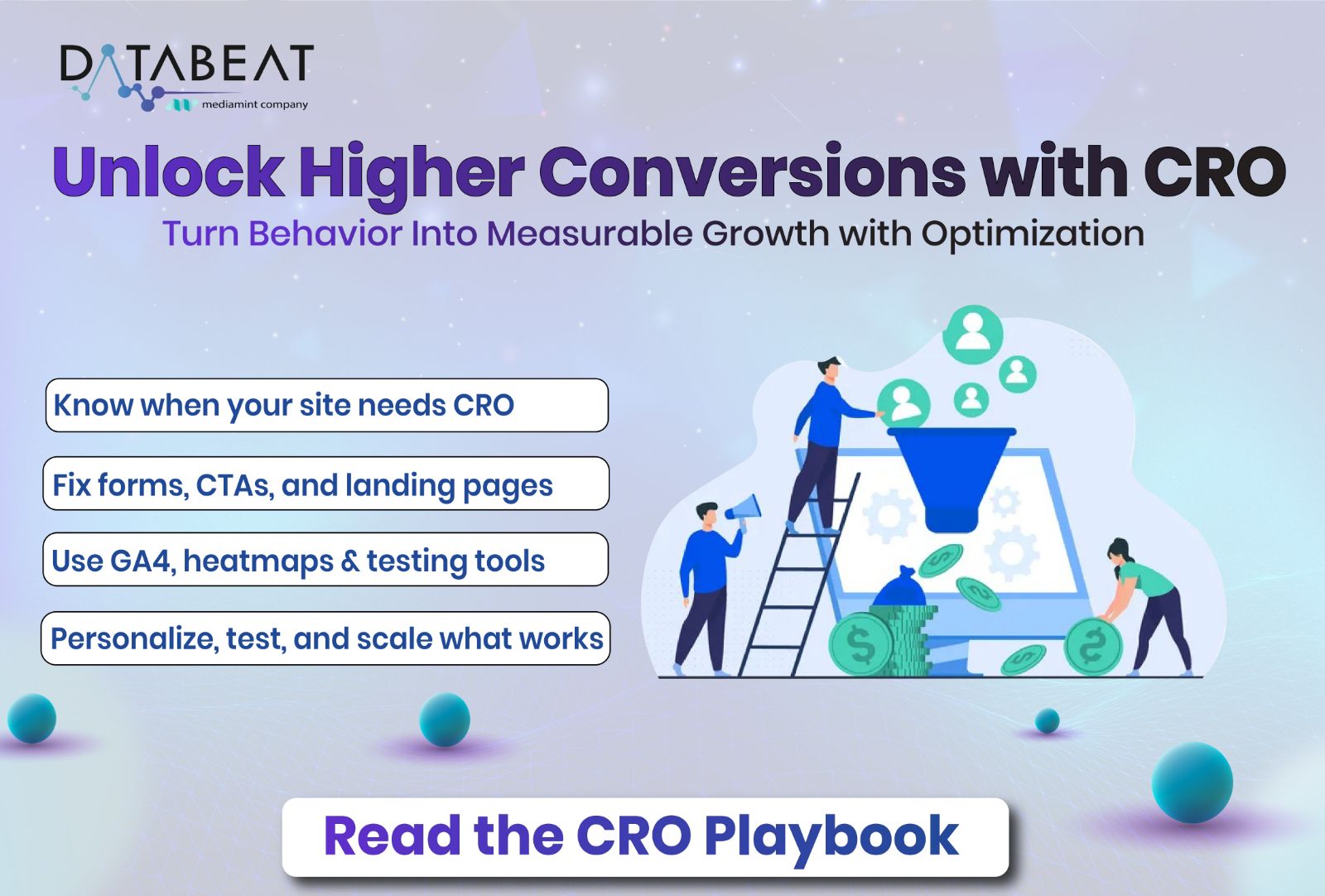
So, What is CRO? let me understand with realtime scenario!! If you have plenty of website visitors, but just not enough leads or sales, then, the problem is not your reach, but your conversion rate. That’s where CRO comes in. No matter whether you’re running an e-commerce website, a SaaS company, or a lead-gen site, e.g. business services, improving the way that people interact with your pages can make a positive, direct impact on results. In this article, we will show you everything you need to know about CRO; what it is, how it works, and how to start optimizing right now.
What Is Conversion Rate Optimization (CRO)?
Conversion Rate Optimization (CRO) is the process of increasing the total number of users completing a desired action on your app or website – making a purchase, signing up, or completing a Call to Action (CTA). Simply put, it’s the process of observing how users interact with your site, testing different variations of content or design, and leveraging technologies such as heatmaps, session replays and A/B Testing to achieve better outcomes. CRO allows you to maximize the traffic you already have, increase ROI without additional ad spend, without having to change the path of your traffic.
How Do You Know If Your Website Needs CRO?
You don’t need a big team to recognize problems with your website. If you’re getting good traffic and not a lot of sales, sign-ups, or clicks, it’s a warning. Some additional indicators would be if you’re seeing a continually high bounce rate, little engagement with buttons, or customers leaving during the checkout process. And also if people are claiming that the site is confusing or hard to use.
This is where Conversion Rate Optimization (CRO) takes its place. CRO shows what users are doing and how to fix the things that stop them from doing what you want them to do. Just little changes could give you a remarkable result; like better layout, bigger CTAs, better navigation, etc. If you’re recognizing any of these issues – it’s time to look into CRO.
How Does the CRO Process Work?
Conversion Rate Optimization is not a guessworks, it is a process that can be replicated based on data, experimentation and learning. Here is the simple, step-by-step approach:
Step 1: Define Your Conversion Goal
Start by defining what you need the user to do.
- Purchasing an item
- Completing a form
- Downloading a brochure
- Subscribing to a newsletter
Specific conversions can help to measure success and guide all future decisions during the CRO process.
Step 2: Analyze Current Performance
Make use of tools like GA4 (Google Analytics 4), heatmaps (Hotjar, Crazy Egg) and session recordings to find out more about how users behave. Review the following:
- Pages where people exit
- Where they get stuck
- How far they scroll(scroll depth)
This will tell you what is working and what is not.
Step 3: Identify Conversion Barriers
Once you understand where users are having trouble, investigate why. Look at the following aspects:
- Slow pages load
- A confusing or unclear CTA
- A confusing layout or broken form
- A mobile experience issue
User experience (UX) issues are typically the biggest barriers to conversion.
Step 4: Develop a Hypothesis for Improvement
Next, turn your insights into ideas. A good hypothesis should read something like:
“If we change our call to action from ‘Submit’ to ‘Get My Free Quote’ we will generate more clicks.”
Differentiate along these lines:
- Headlines
- Page layout
- CTA design or Wording
- Length of form
Step 5: Implement A/B or Multivariate Tests
- Don’t guess, test everything.
- A/B tests test two versions of a page or element.
- Multivariate tests test multiple changes at once.
Ensure tests are run for long enough and achieve statistical significance before conclusions are drawn.
Step 6: Analyze Results and Start Again
- Examine what worked or did not work. Even a test that failed was a success, you eliminated something.
- Double down on strategies that drive increases in conversions.
- Adjust or eliminate ideas that don’t worked.
- Start again with new hypotheses.
- Conversion Rate Optimization(CRO) is an ongoing process, not a one-time fix.
How Do You Optimize Landing Pages?
Prioritize Page Speed: Slow loading times result in lost conversions. Use Google PageSpeed Insights to test and improve your loading times. Compress image sizes, minimize external scripts, and enable caching so as to work towards pages that load in under 3 seconds.
Keep the Design Simple: Confusing pages turn users off. Stick to one simple message and one CTA. Eliminate any unnecessary navigation and distracting elements, and utilize whitespace to separate different sections and highlight anything important on the page.
Use a Mobile-First Approach: With increasingly mobile users, ensure touch elements, such as buttons, are tap-friendly and that your design is responsive. Test your web pages on multiple devices to assess the user experience.
Develop a Strong Value Proposition: Clearly articulate why users need to act now. Use benefit-led headlines, bulleted lists, images, and social proof to get the message across. Keep it simple, short, and free of jargon.
Add Trust Elements: Include testimonials, reviews, trust badges, and real client logos or case studies. Real images are much more believable than stock images.
Examples of High-Converting Landing Pages in Real Life
- Dropbox: Simple design, single bold headline, plain CTA: “Sign up for free.”
- Shopify: Clear value proposition, benefit-focused bullet points, free trial CTA.
- Basecamp: Employs social proof, visual simplicity, and a clear problem/solution story.
These examples show that less is more when the message and CTA are not confusing.
How to Make CTAs and Forms Better?
CTA Placement Is Important: Position your primary CTA above the fold for visibility. Repeat it after important content and implement sticky CTAs on mobile so they remain visible as people scroll. Make CTAs easy to find and accessible.
Clear, Action-Oriented Text: Don’t use vague language like “Submit.” Instead, use specific, value-oriented language like “Get My Free Quote” or “Start My Trial” to describe what the user will receive.
High-Contrast Colors: Utilize prominent contrasting colors, that still work with your branding, to help your CTA buttons and links stand out. Try out various color combinations to find the one that works best for you, just be sure to consider accessibility properly when choosing colors.
Reduce Friction in Forms: Be as minimalist as possible when designing forms; limit the number of fields and display the most important fields first. Consider the use of autofill and progressive disclosure to help your users with their burden whenever possible, make sure you remove all unneeded fields, to reduce drop-off even more.
Establish Trust: Include trustworthy signals like “We’ll never spam you,” testimonials, and logos. Provide reasonable error messages and validations to sure your users can move through forms without hitting errors.
What Role Does Personalization Play?
Personalization can significantly improve your conversion rates by showing users what they are interested in without asking. When someone feels a page speaks directly to them, they are more likely to interact and convert.
1. Dynamic Content
Display location-targeted offers, time-of-day headlines, or user-targeted messaging.
Example: Welcome repeat visitors by name or display previously viewed products.
Easy setup is enabled by solutions such as Optimizely and Dynamic Yield.
2. AI-Driven Recommendations
Use machine learning for personalized product or content recommendations.
Excellent for e-commerce: “You may also like…” areas boost average order value.
Netflix and Amazon are a perfect case in point, content that is customized fuels stickiness and action.
3. Segment Your Audiences
Show disparate messages to new vs. repeat users.
Customize by behavior (e.g., pages viewed, cart abandonment status, device type).
Email and landing page personalization can be coordinated as needed.
In other words, personalization takes one-size-fits-all user journeys and transforms them into custom experiences – which often means more conversions.
Whether to Use Popups and Exit-Intent Modals?
Popups and exit-intent modals can increase conversions, if executed correctly. When done poorly, they will irritate users, but when executed correctly, they are able to capture leads, minimize cart abandonment, and improve engagement.
When to Use Popups:
Use popups appropriately, for example retrieving a discount or lead magnet for new visitors, or an exit-intent modal to present last attempt offers while users are leaving.
Best Practices:
- Use the popup to complement the page’s content, and display after the visitors have engaged with the site.
- Encourage with direct CTAs, such as “Get 10% Off” instead of indirect cues like “Subscribe.”
- Show the popups once per visit, and make it easy for the visitor to close.
- When used intentionally and tested thoroughly, popups or modals can increase conversions without ruining the user experience.
Conclusion
Working on Conversion Rate Optimization isn’t optimizing a button it’s about a methodical process which aims to convert more visitors into customers. With set objectives; user behavior analysis; and evidence-based changes you can improve performance without new traffic. Whether you’re optimizing a landing page; optimizing the call to action; or introducing personalization; small enhancements equate to great results. Test, learn, and let your website do more with what it already has.
How Can DataBeat Help?
At DataBeat, we assist brands in discovering overlooked conversion opportunities through user behavior data sense-making. From drop-off point identification with session replays and heatmaps to conducting data-driven A/B testing, we assist you through the CRO process from start to finish. Our experts work with marketers to optimize landing pages, optimize CTAs, and personalize user paths based on actual insights, not hypotheses. Whether you’re working with high bounce rates or low form completions, our practical strategies make each click more likely to convert. DataBeat doesn’t just drive traffic, it converts it.

